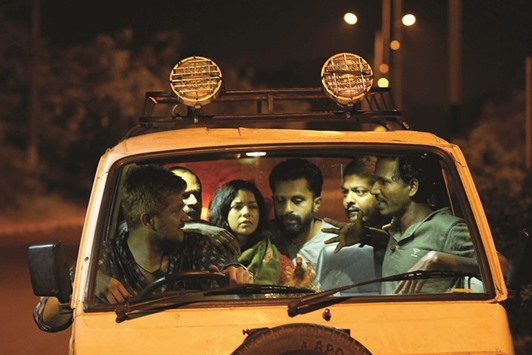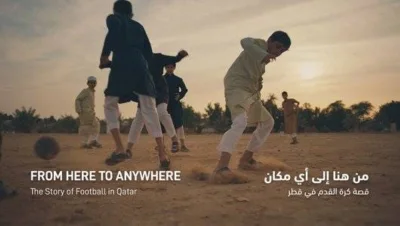It has been my firm view that the Film Bazaar – which is organised by the National Film Development Corporation of India and which runs along with the International Film Festival of India in Goa’s Panaji – is a fantastic venue to watch some of the latest Indian movies that are yet to hit the theatrical or festival circuit. I saw several exceptionally engaging works at the recent Bazaar, which held its 10th edition. Here are two.
Sanal Kumar Sashidharan’s Sexy Durga was one. Now, please do not ask me how is he going to get past Indian censors, given the title. But Sashidharan, a lawyer-turned-filmmaker is confident that he will sail past any obstacle. It is this self-assurance that one sees in the cinema he creates. And what is more, he has this amazing ability to surprise even a hardcore critic like me.
Sashidharan’s debut feature, An Off-Day Game (Ozhivudivasathe Kali), in Malayalam, was almost magically unpredictable that narrated the drinking bout of some friends on a holiday in a desolate bungalow which turned notoriously evil. The climax was so eerie that it sent shivers down my spine. Can pals turn so cruel? Obviously they can, according to Sashidharan’s movie, which is also deeply layered, disturbing us with a revelation that men can be terribly casteist.
In contrast, Sashidharan’s second feature, Sexy Durga, attempts to tell us that men can be magnanimous when they want to be. And this emerges on a dark night, on a lonely highway – “which is a scary place after sunset”, the young director quips during an interview with me at the Bazaar.
The film opens with a young woman, Durga (Rajashri Despande), anxiously waiting on a deserted road in the middle of the night – till Kabeer (Kannan Nair) arrives. We do not know whether they are married, but we are sure that they are eloping from an undisclosed destination to Chennai. They have to reach a train station, and have to thumb a lift to get there.
Unfortunately, the small van that stops by has two men, all sozzled up. And the ride for the couple turns nightmarish. One of the men ogles so hard that Durga is not just uncomfortable, but terrified, and a point comes when she wants to get off. The men do not allow this, saying that the highway is dangerous at night.
Durga and Kabeer meet a group of motley men that night, a night which never seems to end, and on a road which never seems to lead to a train station. And the journey for the couple – perhaps already in a fix – gets more and more scary.
Sashidharan has this enormous ability to lead us up, but present us with something totally unforeseen. He plots Sexy Durga in a way whereby he conveys fear without actually resorting to violence. There is nothing remotely violent in the movie, but Durga is nonetheless petrified, her inability to understand Malayalam (she is a north Indian) adding to her torturous plight. Even as she keeps urging Kabeer that they get off the vehicle and even as she keeps pleading with the men to stop the van (“But this is an unsafe place”, they keep interjecting), one can see terror writ large on her face.
In Sexy Durga, it is the word fear that we keep hearing with the drunks telling the couple, the woman in particular, not to be afraid. But it has quite the opposite effect. As Sashidharan says, the threat of violence, the possibility of violence is far more disturbing to the human psyche than actual force and ferocity are.
Intercutting into the film’s narrative is the festival of Garudan Thookkam – where devotees pierce themselves with iron hooks and rods – a practice that the helmer feels is a clear indication that aggression and violence are an integral part of Indian society. “Also, people are oblivious of this. They have a very callous attitude towards violence and are never bothered by violence unless it strikes them...It is a selfish society,” he adds.
The second work that I quite liked was Jiju Anthony’s Eli Eli Lama Sabachhani ? (The Forsaken) in Marathi. The movie borrows primarily from the brutal Nirbhaya rape and murder case that rocked Delhi and the rest of India a few years ago. It was the viciousness of the culprits (one of them was a teenager, and he is said to have been the most violent of the lot), who not only raped a young girl but also killed her in an unimaginably brutal way.
But interestingly, Antony’s film goes beyond rape and murder to show us how his protagonist, Prashant (played by Sanal Aman from Delhi’s National School of Drama) turns into a beast. Dividing his movie into several chapters – each distinguished by a different hue – he elaborates on the gruesome incident of how Prashant, a taxi driver, takes a couple (necking each other) to a lonely stretch in Mumbai, beats the man into unconsciousness, rapes the woman and bludgeons her to death. Prashant is like an animal in rage.
Eli Eli Lama Sabachhani? starts with a hanging in a jail, and we watch a desperately hapless Prashant writhing in mental agony as he is literally dragged by policemen to the gallows. This scene is repeated at the end for dramatic effect, which the director carries out with a touch of engaging attention to detail.
But before the ghastly crime actually happens, we are witness to a Prashant – who as a boy sees domestic violence (his mother being raped by his father), and experiences hurt and humiliation as a grown-up man. His rich employer, a woman who hires him to drive her car, ridicules Prashant when he uses the family’s toilet or when he forgets to buy flowers from the market. She seems unusually haughty and sarcastic. At another time, Prashant is shamed by the prostitute he visits – when he suffers from performance anxiety.
The film conveys in no uncertain terms that Prashant is a victim of an unfeeling society that turns an innocent boy into a fire-breathing monster – who would not flinch to kill with a kind of bestial force which seems as a release for all his pent-up frustrations.
In a chat with me at the Bazaar, Antony – who has taken a break from an executive assignment in Dubai to spend time with his autistic son (nine now) – says that before starting to shoot his debut work, Eli Eli... he had not even been to a movie set. “But being at home, I had this great privilege of following news and discussing it with my wife. When Nirbhaya was brutalised, and when other women in an abandoned Mumbai mill (here a journalist was attacked) and in Kerala (a poor, low caste girl fell prey) suffered at the hands of perverted men, I decided to make a film,” Anthony avers.
In a way, while spending a lot of time with his child, Antony began to wonder why the innocence of childhood mutates into criminality. “I think the community a child grows up in is largely responsible for turning a boy into a rapist, pushing him to the precipice of frustrated dejection – a point from where he finds it almost impossible to walk away. The movie is nothing but a kind of soul searching. I have tried to address several implications of how societal influences can do irreparable harm to a child...As an infant, as a teenager, as an adult.”
Also, economic and social disparities push a child into a confusing abyss. “We were shooting in Mumbai, near actor Shah Rukh Khan’s house, and I was appalled to see slums just next to his bungalow...All this contributes to anger, which can lead to a tipping point in a man’s life. Prashant was a product of such uncaring society.”
There are other provocations, and Antony talks about the negative impact of Bollywood. “I had this song, Sheela Ki Jawani, playing in the background, and I have also inserted a scene where we see girls talk about Salman Khan’s handsomeness...All these can destabilise the mind of a man. And the environment he has grown up in or where he is then living can have a huge influence on his thought and action.”
Prashant was a victim of such a community, and Antony’s English title, The Forsaken, is apt. The helmer implies strongly how the child, the teen and the man in his work are pushed into a hopelessly dark pit. An escape from there is possible only for a price. The price may be ghastly, and The Forsaken appears to be telling us this.
** Gautaman Bhaskaran covered the
Film Bazaar, and may be e-mailed
at [email protected]

Sexy Durga is an exercise in showing that the possibility of violence is far more disturbing to the human psyche than actual force and ferocity are.


